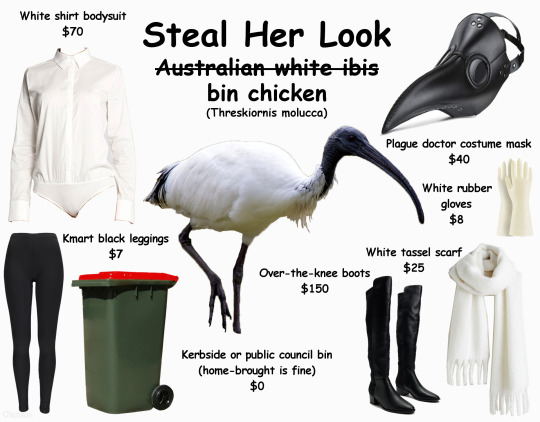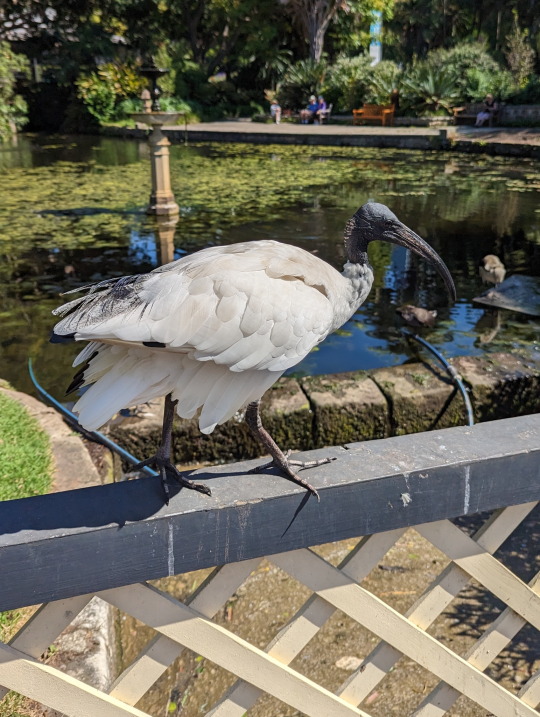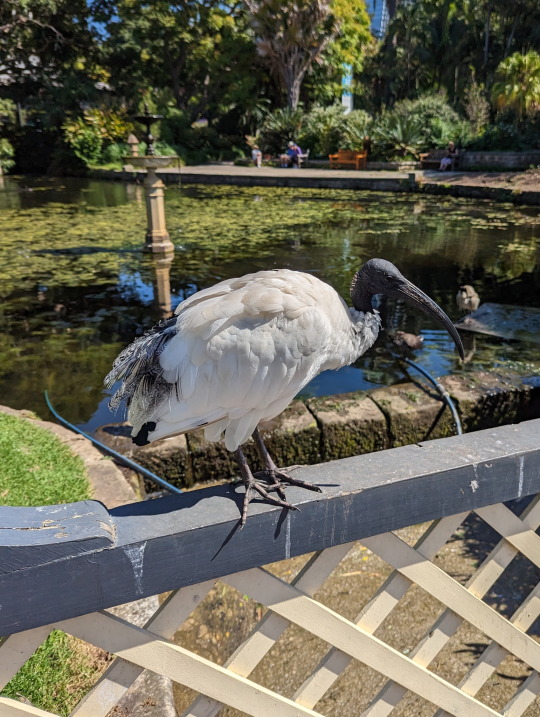#Threskiornis molucca
Explore tagged Tumblr posts
Text

#I had to make a worse one lol#bin chicken#ibis#Australian white ibis#Threskiornis molucca#white ibis#birds#birdblr#eastern rosella#Australia#Australian wildlife#parrots#parrot#psittaciformes#bird#steal her look#steal their look#steal his look#memes#fit guides#outfit guide#toe shoes#rainbow#steal her style#style#steal his style#character design#outfit design
111 notes
·
View notes
Photo


The Rubbish Bird
So called because of their new natural habitat, Australian rubbish bins.
Threskiornis molucca
18/03/23
11 notes
·
View notes
Text
I present to you the runner up for Australia's 2017 national Bird of the year competition. Everyone give them a chippie.
nothing has fucked me up more than knowing the australian white ibis has a near-identical sister species called the african sacred ibis. the african sacred ibis is associated with thoth, ancient god of wisdom and reason. the australian white ibis is most commonly referred to as a “bin chicken”.
#they sound like geese#and they absolutely love garbage#if you're american you might call them a trash turkey#they're water birds though and nest in trees next to a water source#Threskiornis molucca#australian white ibis#threskiornis#ibis#Pelecaniformes#Aequornithes#aves#birds#animals#metazoa
73K notes
·
View notes
Text

Australian White Ibis (Threskiornis molucca), family Threskiornithidae, order Pelicaniformes, QLD, Australia
photograph by Kristeen Schulte Baggetto
#ibis#threskiornis#threskiornithidae#wading bird#pelicaniformes#bird#ornithology#animals#nature#australia
395 notes
·
View notes
Text
Great Backyard Bird Off - Australia (poll 2)


Bird Info & Submission Reasons
Australian Ibis (Threskiornis molucca)
""You steal my habitat, I'll steal your rubbish!" What's there not to love about that attitude?!"
"I just think they're neat"
"It’s colloquially referred to as bin chicken. It’s everywhere. Sometimes they perch on roofs in groups of 3-5 like some imitation-gargoyles."
"I see them frequently in my city and they're p funky looking"
"Loathed by Australians everywhere, their hooked beaks are uniquely adapted to steal food from bins"
"BIN CHICKEN SUPREMACY"
Satin Bowerbird (Ptilonorhynchus violaceus)
"They stole all my blue pegs and I'm not even mad about it... full respect for their commitment to the aesthetic!"
Large plump bowerbird with short bill. Adult males are entirely dark glossy blue-purple color with a pale bill and bright violet eye. Adult females and immatures are primarily green and brown, with blue/pink eyes and scalloped underparts. This species can be quite loud and vocal (screeches, hisses, yowls). It is often encountered in pairs or small groups. Males are well-known for building a large bower decorated with small blue objects. Found in rainforests and wet eucalypt forests of eastern Australia. (eBird)
Image Sources: ibis (Ian Hearn), bowerbird (Paul Rankin)
#Great Backyard Bird Off#bird poll#animal poll#Australian birds#oceania birds#australasian birds#australian ibis#bin chicken#satin bowerbird
6 notes
·
View notes
Text
Cooleenup Island Species List - BIRDS - June 9th to 11th 2023
12C-18.5C, 2.4mm-12.5mm rain, strong wind on Sunday
(taxonomic order and nomenclature follows Clements, version 2022)
Pacific Black Duck Anas superciliosa Mallard Anas platyrhynchos Common Bronzewing Phaps chalcoptera Laughing Dove Spilopelia senegalensis Eurasian Coot Fulica atra Silver Gull Chroicocephalus novaehollandiae Caspian Tern Hydroprogne caspia Greater Crested Tern Thalasseus bergii Australasian Darter Anhinga novaehollandiae Great Cormorant Phalacrocorax carbo Pied Cormorant Phalacrocorax varius Great Egret Ardea alba White-faced Heron Egretta novaehollandiae Australian Ibis Threskiornis molucca Yellow-billed Spoonbill Platalea flavipes Swamp Harrier (immature) Circus approximans White-bellied Sea-Eagle Haliaeetus leucogaster Sacred Kingfisher Todiramphus sanctus Galah Eolophus roseicapilla Little Corella Cacatua sanguinea Australian Ringneck Barnardius zonarius Redcap Parrot Purpureicephalus spurius Splendid Fairy-wren Malurus splendens Red Wattlebird Anthochaera carunculata Spotted Scrubwren Sericornis maculatus Inland Thornbill Acanthiza apicalis Western Gerygone Gerygone fusca Black-faced Cuckooshrike Coracina novaehollandiae Gray Butcherbird Cracticus torquatus Australian Magpie Gymnorhina tibicen Gray Fantail Rhipidura albiscapa Australian Raven Corvus coronoides Scarlet Robin Petroica boodang Welcome Swallow Hirundo neoxena Tree Martin Petrochelidon nigricans Silvereye Zosterops lateralis
2 notes
·
View notes
Text
I photographed this Australian white ibis (Threskiornis molucca) on my January 2023 trip to Kangaroo Island but haven’t edited it until now. Many believe they’re a feral species introduced to Australia, similar to foxes or hares. But these ibises are, in fact, native Australian birds.

#travel#trip#nature#canon#australia#wildlife#wildlifephotography#birdphotography#bird#kangarooisland
1 note
·
View note
Text

Bin Chicken - Australian white ibis (Threskiornis molucca)

thinking about him
1K notes
·
View notes
Video
Australian White Ibis by Anna Nielsson
5 notes
·
View notes
Photo

Only a drunk Australian who is missing home would want a smoker bin-chicken tattooed on his arm hehe! It's been a pleasure to do it honey, and I really like how it looks like! 💙 see you soon @andrewmaguny 💙 #Threskiornis #molucca #Threskiornismolucca #ibis #ibistattoo #whiteibis #whiteibistattoo #australianibis #birdtattoo #tattoo #blacktattoo (presso Pianoro)
#whiteibistattoo#threskiornis#ibis#ibistattoo#whiteibis#molucca#australianibis#tattoo#blacktattoo#birdtattoo#threskiornismolucca
1 note
·
View note
Text

A royal bin chook. Australian White Ibis (Threskiornis molucca). Bin chooks are large birds endemic to extensive marshes, more than 600km north-west of here. Sydney's Taronga Zoo released a collected flock in 1971 as a "free-flying exhibit" of their spectacular flight, but they're now superbly adapted as an urban pest species and scavenger, with long legs, necks and curved bills. Droughts drove more birds to the East Coast, and they stayed, bred with the others and became a recognised pest by 1998. They nest in the crowns of the thousands of Canary Island Palm trees planted as work creation projects in Sydney during the Great Depression, have no fear of humans, and they no longer breed in their original range. The Ibis get around in packs throughout the Inner West and they stink. Human garbage is their favoured food and they find paradise in an open dumpster. They make a loud honking sound in flight. Paradoxically, a much loved bird. Paintwork by Nick Sweetman. Newtown.
#street art#bird#bin chook#urban environment#white ibis#laneway art#spray#birdlife#wildlife#birds are real#pests#tags#streetscape#it's a sign#pictures on walls#street scene#ephemeral#inner west sydney
64 notes
·
View notes
Note
Are we talking common names here? Cause if we're talking common names I'd argue you don't even need to find a new species.
Common names are just, well, commonly used and recognized names. The only "regulated" names are the scientific ones. As my botany professor once told me, if someone asks you for a common name for a species, just make it up because it's as real as any other common name.
For example, since neither are Latin binomial names, "Australian White Ibis" and "Bin Chicken" are both equally valid common names for Threskiornis molucca. Debatably Bin Chicken is the better common name because I could remember it and I could Google it to find the scientific name.
Which is all to say, just pick any bird, give it a nickname, get the nickname to catch on, boom you named a bird.
If you find a new kind of bird can you name it anything? I want to name a bird the Ass Grabber 5000.
i respect the hustle but I’m pretty sure it doesn’t quite work like that
#this might be a hot take lol#btw to scientifically name a species you have to publish a paper explaining how to ID the species as it compares to related species#generally you have to be specialized in the specific group the new species belongs ro#which means#at least in my entomology experience#the people discovering the specimens that turn out to be new species#arent the ones describing and naming the new species
575 notes
·
View notes
Photo

Australian White Ibis (Threskiornis molucca)
Coolart Wetlands and Homestead Reserve, Mornington Peninsula, Victoria, Australia
3 notes
·
View notes
Photo

Bin Chicken Island in Melbourne, Australia Bin chickens have made their way into the Macquarie Dictionary otherwise known by the scientific name Threskiornis molucca, or the common name white ibis. From the dictionary to a small island in a Melbourne suburban park, people both love and loathe them. Ibis have entered the Australian English lexicon as, "tip turkeys," "sandwich snatchers," and "picnic pirates." But "bin chickens" are their most common name, due to the habit of raiding rubbish bins for sustenance. With three species native to Australia, these birds have been migrating to urban areas along the east coast of Australia since the 1970s. As a native Australian bird, they are protected under the Wildlife Act 1975. White ibis were first recorded in Melbourne's northern suburbs in 2009. There has been a rapid expansion of the ibis population between 2018-2020. Since then, there has been a growth in the colony of these birds. As a protected habitat the island is perfect for the ibis. In addition, the birds play an important role in natural pest management as they eat small insects, grubs, and fish. The white ibis also usually nest between October and March. The community has raised concerns about the noise, smell, and behavior of the colony, as well as its impact on the reserve's environment and amenities including damage to vegetation and a reduction in other bird species. It looks like the "bin chickens" are winning the fight on the small island as with many urban areas for now. https://www.atlasobscura.com/places/bin-chicken-island
0 notes
Photo

“BIN CHICKEN” AKA “Tip Turkey. An Australian White Ibis (Threskiornis molucca) wading (rummaging) in the rubbish in downtown Sydney Done from a Wikipedia photo, so it’s a Virtual Sketchwalk. Another in the Sydney series. Sketched very quickly with a PLATINUM Carbon Desk fountain pen with PLATINUM Carbon ink in a 5.5” x 8” IKEA sketchbook. INKTOBER 2020. #LobstArtstudios #dessinateur #artist #dessin #sketch #drawing #quicksketch #RanDOODLINGdom #croquisrapide #croquis #szkic #platinumcarbondeskpen #platinumcarbon #platinumcarbonink #australianbirdd #sydneybirds #sydneyaustralia #pandemicsketching #sydneY #sydneynsw #blackandwhite #inktober2020 #virtualsketchwalk #binchicken #australianwhiteibis (at Sydney, NSW, Australia) https://www.instagram.com/p/CG9ujh7ntbN/?igshid=xs23ra9hw00r
#lobstartstudios#dessinateur#artist#dessin#sketch#drawing#quicksketch#randoodlingdom#croquisrapide#croquis#szkic#platinumcarbondeskpen#platinumcarbon#platinumcarbonink#australianbirdd#sydneybirds#sydneyaustralia#pandemicsketching#sydney#sydneynsw#blackandwhite#inktober2020#virtualsketchwalk#binchicken#australianwhiteibis
0 notes
Photo










Visit to Barrambbin (Victoria Park) 09.09.2020 ft.
Threskiornis molucca Threskiornithidae (Australian White Ibis)
http://www.birdlife.org.au/bird-profile/australian-white-ibis
Porphyrio porphyrio Rallidae (Purple Swamphen)
http://birdlife.org.au/bird-profile/Purple-Swamphen
Anas superciliosa Anatidae (Pacific Black Duck)
http://www.birdlife.org.au/bird-profile/pacific-black-duck
Cracticus tibicen Artamidae ( Australian Magpie)
http://birdlife.org.au/bird-profile/australian-magpie
0 notes
